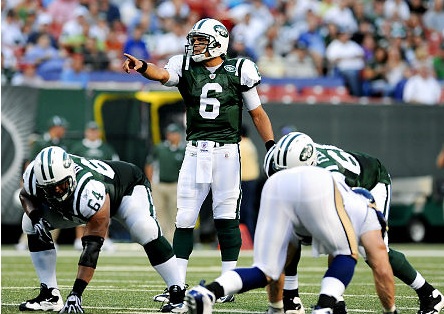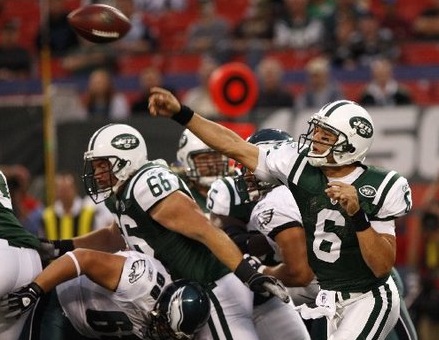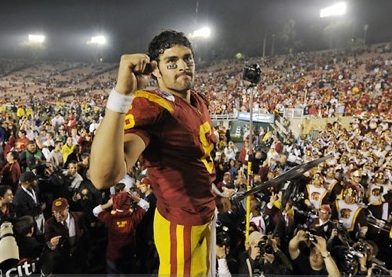Last April, the Monday after the Jets traded up to draft Mark Sanchez, just up the block from the Roosevelt Avenue taco wagons, their new quarterback got a huge ovation before throwing out the first pitch (a high fastball) at Citi Field. It was a public coming out party, and a savvy one, as Mets and Jets fans tend to share the same brains. No matter their baseball allegiances, Jets fans of all stripes are hoping that the cocksure Southern California kid becomes the 21st-century Joe Namath. But for New York City's fastest growing Latino group, he has the chance to become much more. Don't be surprised if you see a lot of #6 jerseys in Jackson Heights. As Sanchez told smitten-like-a-schoolgirl Mets announcer/Jets season ticket holder Gary Cohen, "I'm proud to be a Mexican-American."

Since then, Sanchez has made adjusting to the NFL his singular priority, a smart move for a rookie trying to establish himself in a tough league in a tough town. The "Sanchize" has had flashes of greatness (the throttling of Houston, the comeback victory over New England), the opposite of greatness (the not-unexpected New Orleans loss, the total meltdown against Buffalo) and a lot of in-between. For a first year quarterback, though, Sanchez appears up to the challenge and Jets fans seem to be willing to give him plenty of leeway in the big picture hope that one day soon, head coach Rex Ryan will shake Barack Obama's hand as promised.
A Jets spokesman said that Sanchez is concentrating on football for now, but it will be interesting to see if his relationship with his new city's Mexican community grows along with his stature. He's never been shy about his heritage, but if he's like most New Yorkers, he probably has no idea how big the community is becoming. Quietly, Mexican NYC is poised to become a major force in the city's ever-shifting demographics, and they are going to need leaders. A 6'2" 225 lb. good-looking Super Bowl-winning quarterback never hurt.

Since 2000, the official Mexican population in New York City has exploded by 58% to 290,000. At the current rate, Mexicans will make up the city's largest Latino group in less than twenty years. Yet the community flies under-the-radar, at least when compared to its long-established Puerto Rican and Dominican counterparts. It's estimated there are another 200,000 Mexicans living here off the grid, so staying out of the public eye amounts to a survival mechanism. "There are local leaders, but at this point, there isn't a face recognized by the larger 'American' community," says Robert C. Smith, a sociology professor at Baruch and author of Mexican New York.
Sanchez, son of an Orange County fire captain, grew up in a typical suburban neighborhood. He was a star at Mission Viejo High School and by all accounts, his ethnicity didn't play a big role in his life as a teenage jock. He certainly didn't enroll at USC intending to be El Hombre, but thanks to USC's rabid Mexican fanbase, he realized he was playing for something bigger and embraced his heritage.
In 2007, in only his second start, Sanchez broke out a tri-colored Mexican flag mouthpiece featuring an eagle taming a serpent, as a fan-friendly nod to his people. The gesture endeared him to his supporters (The four touchdowns he'd thrown at South Bend in a 38-0 whitewashing of Notre Dame that put the echoes back to sleep didn't hurt either), but it also brought him unwarranted attention from the talk radio troglodytes who believe in all-American dental protection. Sanchez told NFL.com that he received hate mail imploring him to "Go back to Mexico," and the message board trolls posted even less-enlightened excoriations.
It was too late. Sanchez was on his way to becoming a folk hero. By the time he took over the reigns as the starter in 2008, the LA Coliseum was festooned with lucha libre masks, ponchos, sombreros and Viva Sanchez! tee-shirts, and the USC band belting out the Los Fabulosos Cadillacs hit "El Matador" in his honor.

As Sanchez grew more comfortable as a role model, he became more visible, but he's hardly a radical. The Bandera Nacional mouthpiece was shelved after the ND game and Sanchez has never spoke out politically. He follows the noncontroversial script of the modern athlete. His USC outings were events like joining mayor Antonio Villaraigosa in handing out holiday gifts in East L.A., and speaking to school groups. Even in the Citi Field booth, Sanchez followed up with Cohen by adding that "most importantly" he was proud to "be an American where we can celebrate our heritage like that."
Bland bromides aside, being in the spotlight has given Sanchez a deeper understanding of how, like it or not, he's a role model for the Mexican community. It's facile, not too mention unfair, to expect any celebrity to become a pillar of the community, but it's also phony to pretend that immigrant groups don't rally around their own. Millionaire athletes speaking for working class people is an odd juxstaposition, but If Sanchez follows the blueprint of setting up a local foundation, making PSAs promoting fitness, education, etc., and doing charity events, he instantly becomes the highest-profile Mexican voice in New York City.
If he lives up to the hype, Sanchez's combination of charisma and fiery in-your-facemask style will be a marketer's dream, and his timing as a high-profile Mexican in New York City couldn't be better. In Los Angeles, Sanchez had the backing of the massive Mexican fanbase and a top-tier team to work with, so he was in a strong position. It won't be so easy winning over the on-edge fans of the historically wayward Jets, but if he does, Sanchez is primed to become not only the face of the franchise, but also of a community that won't be keeping to itself much longer.
Joel Magallan, executive director of the education-focused Tepeyac Association, points out that the community's New York City population boom started in 1990, so a generation of legally born American citizens of Mexican descent will be coming of age. The children will be more educated, assimilated, and not content with a quiet existence. "We've lacked for public figures, but soon we will have our own elected officials, business leaders and celebrities," says Magallan, "I think Sanchez will be a great fit."
Mexican New York City is growing fast, ready to become the next of the city's bedrock voices. And while they share many of the same problems as other Latino groups, there are cultural differences and issues--namely immigration--that help define their identity. The second generation of Mexican New Yorkers is going to claim their piece of the city, just like every immigrant group before them. Sanchez could have a significant impact simply by being a symbol. But if he sincerely adopts Mexican New York City and works on its behalf, Sanchez can become their favorite son.
Ultimately, Sanchez will be judged one first down marker at a time, but if nothing else, the itinerant dishwasher can get a stick-it-to-the-man charge out of watching Sanchez scramble across the goal line. After years of being subjected to Lou Dobbs demagoguery, calls to build an even bigger border fence, threats of mass deportation, Minuteman Project posturing, and the cries for quarantining the unwashed scourge behind the Swine Flu Pandemic, Mexican New York City can take extra pride if one of their own becomes Jose Namath.